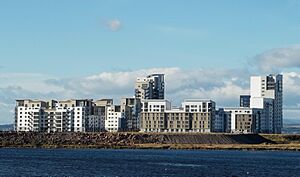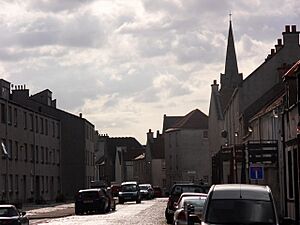Newhaven, Edinburgh facts for kids
Quick facts for kids Newhaven |
|
|---|---|
 Newhaven Harbour, October 2010 |
|
| Council area |
|
| Lieutenancy area | |
| Country | Scotland |
| Sovereign state | United Kingdom |
| Post town | EDINBURGH |
| Postcode district | EH6 |
| Dialling code | 0131 |
| Ambulance | Scottish |
| EU Parliament | Scotland |
| UK Parliament | |
| Scottish Parliament | |
Newhaven is a cool part of Edinburgh, the capital city of Scotland. It's located between Leith and Granton, about 2 miles (3.2 km) north of Edinburgh's city centre. It's also just north of the Victoria Park area.
Newhaven used to be a busy fishing village with its own harbour on the Firth of Forth. In 1991, about 5,000 people lived there. Newhaven became a special "conservation area" in 1977. This means its unique buildings and history are protected. Many old houses have a special outdoor staircase called a "forestair" leading to the first floor. Downstairs, fishermen used to store their nets.
Newer homes built in the 1960s were designed to look like these older buildings. Victoria Primary School, built in 1844, is a historic building on Newhaven Main Street. It was the oldest council primary school still in use in Edinburgh until 2021. That's when students and staff moved to a new building in Western Harbour. The old school building is now being turned into a community hub by a local charity.
The new Western Harbour area stretches out into the Firth of Forth from Newhaven. It's also home to the David Lloyd Newhaven Harbour sports centre. Famous tennis player Sir Andy Murray used to play tennis there when he was young!
Contents
Newhaven's Past: A Fishing Village
Early Days and Shipbuilding
Newhaven sits on land that was once a prehistoric beach. It was part of North Leith Parish. This area was once a busy fishing village and a place where shipbuilding happened. King James IV wanted to build a strong Scottish navy. But the port of Leith wasn't big enough for large warships.
So, in 1504, he created "Newhavin," which means "new harbour." It was built especially for making a huge warship called the Michael (also known as the "Great Michael"). This ship was built between 1507 and 1511. The spot where the first harbour was built is now an open space called Fishmarket Square.
You can still see parts of the Chapel of St. Mary and St. James in Lamb's Court and Westmost Close. People believe this chapel was built for the dockyard workers and sailors. By 1611, the chapel was in ruins. In 1766, a group called the Society of Free Fishermen bought the land to use as a graveyard until 1848. Later, in the time of King James VI, some clever people from Flanders set up salt pans in Newhaven. They used these to make sea salt.
From 1572 to 1890, Newhaven was a major port for catching oysters. In 1881, a terrible storm hit, known as the Eyemouth disaster. Out of 400 fishermen in Newhaven, 17 lost their lives. This included fathers and sons, or brothers, who were fishing together. In Newhaven alone, nine women became widows, and 57 children lost their fathers.
Life as a Fishing Community
Even though Newhaven was close to Edinburgh, its people kept their own special ways of dressing and traditions. Because of this, the village and its residents were often photographed. Famous Victorian photographers like David Octavius Hill and Robert Adamson took many pictures. They photographed the fishermen and fishwives of Newhaven in their village and at their studio in Edinburgh.
The Society of Free Fishermen of Newhaven was one of the oldest friendly groups in Scotland. It started at least in 1572 and lasted until 1989.
Newhaven in the 19th and 20th Centuries
For a long time, until the end of the 1900s, the people who guided ships on the Firth of Forth (called pilots) often came from Newhaven families. These early pilots had their own fast and strong sailing boats.
Newhaven used to have a train line, the Edinburgh, Leith and Newhaven Railway, connecting it to Edinburgh and Leith. But this line closed in 1956. You can still see the old station building and platform near Trinity Crescent. Newhaven was also connected to Stirling by steamboat. The journey of 42 miles took just over 3 hours.
Newhaven's fishing boats also played a part in the whaling industry. That's why there's a place called "Whale Brae" at the end of Newhaven Road. The house of the whalemaster (number 13) had clear views down to the harbour.
Modern Changes in Newhaven
In the 1950s and 1960s, Edinburgh's city planners changed Newhaven. Main Street was almost completely taken down, but then rebuilt to look similar on its north side. The south side was rebuilt with modern three-story flats. Other new buildings in the area were designed by a famous Scottish architect, Sir Basil Spence.
There's a 16th-century stone panel on the south side of Main Street, known as the "Newhaven Stone." It seems to have come from an old farm called Trinity Mains Farm. This farm was linked to Trinity House in Leith, whose symbol is on the stone. The farm gave its name to the nearby area of Trinity. A copy of part of this panel is in the local primary school.
The old Victorian fishmarket on the east side of the harbour was saved from being knocked down in 1990. It was first turned into a large restaurant. Now, it's the Loch Fyne restaurant, and part of it is still a working fishmonger where you can buy fresh fish. The Newhaven Heritage Museum, which was in a small room there, closed in 2007. Some of its exhibits are now kept by Victoria Primary School.
New buildings north and north-east of the village are much bigger than the original village. Now, many parts of Newhaven look out onto tall, modern apartments instead of the Firth of Forth.
Getting Around Newhaven
Buses
Lothian buses serve Newhaven. Bus routes 7 and 11 go straight to the city centre. The 16/N16 connects to Leith and then to the city centre.
Tram
Newhaven used to have a tram route in the early 1900s, which closed in 1956.
The Edinburgh Trams light rail line was extended and opened in June 2023. It now connects Newhaven to the city centre and the airport. The tram line ends at the Newhaven tram stop, which is located on the north side of Lindsay Road.
| Preceding station | Edinburgh Trams | Following station | ||
|---|---|---|---|---|
| Terminus | Newhaven – Edinburgh Airport | Ocean Terminal towards Airport |
Harbour
A lighthouse built at the harbour entrance in 1869 is a well-known local landmark. The harbour now seems small compared to the much larger Leith Harbour nearby. The old Victorian fishmarket is now a smaller, working fishmarket and the Loch Fyne restaurant.
In 2021, it was confirmed that the historic Victoria Primary School building will become a future home for a charity called Heart of Newhaven Community. This happened after they received a grant from the Scottish Land Fund to buy the building.
Special Events in Newhaven
Like other historic villages, Newhaven has an Annual Gala Day in May or June. A decorated "royal barge" brings the "Gala Queen" and "Fisher King" (who are young children chosen each year) across the harbour. They then lead parades, celebrations, and music.
The war memorial next to the Victoria School is where annual Armistice Day ceremonies are held. On October 14, 2021, a special memorial was planned for the 140th anniversary of the Eyemouth disaster. It remembered all the men lost in that storm and everyone lost at sea.
Famous People from Newhaven
- Jimmy Campbell (born 1886), a professional football player who played for Scotland in 1913.
- Hannah Gordon (born 1941), an actress.
- Jimmy Rutherford (born 1917), a volunteer who fought in the International Brigades. He was sadly executed at age 20.
- The 17 men who lost their lives in the Eyemouth disaster in 1881.



